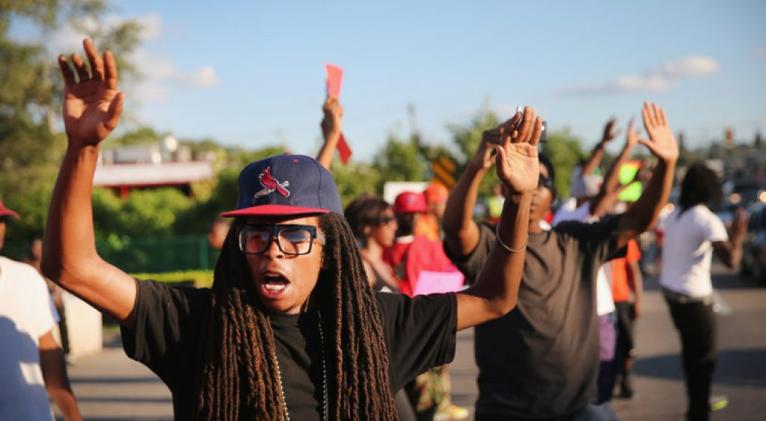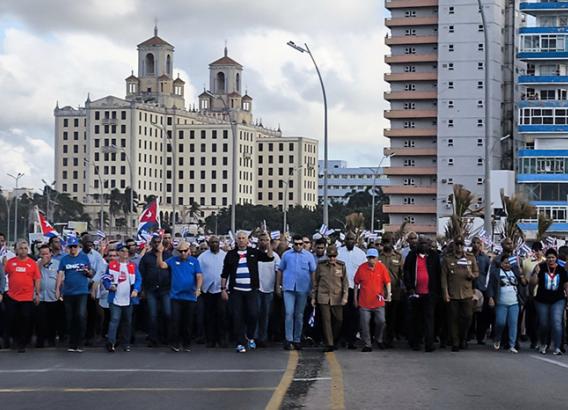What we know about who police kill in America
especiales

In the wake of Michael Brown's killing, there's been a rush to figure out how often something like this happens in America. The problem, as several writers have found in the last few weeks, is that no one collects data that answers exactly that question. There is no national database that police departments are required to submit a record to when they complete an investigation after a police officer shoots a civilian.
vox has obtained fbi records that go beyond raw numbers and reveal details about victims and the circumstances of their deaths
The FBI does collect some data, however. Many have reported that the FBI's records say that there were 426 "felons killed by police" in 2012. Now, Vox has obtained FBI records that go beyond the raw number of police-involved homicides and reveal details about the victims and the circumstances surrounding their deaths. The data offers an important look at what the FBI knows about people killed by police in America.
The FBI data has tremendous limitations. It represents the minimum number of people who were killed by police in 2012, and there's no way to know how many cases are left out. But while it tells us just a little about how many people are killed by police, it tells us more about who those people are, and what police say about why they were killed. Furthermore, it hints at a theme that's woven through the events of the last two weeks in Ferguson, Missouri: that the experience of dealing with police in America is different for whites and nonwhites.

A street memorial to Michael Brown.
How the FBI collects data on officer-involved homicides
The FBI collects records from local and state law enforcement on a monthly basis as part of their Uniform Crime Reporting system, which is what they use to produce official reports of crime rates in the US. (Participation is voluntary, but more than 18,000 agencies participate.) Those records tell the FBI how many crimes were committed and what type, but it doesn't say much about the characteristics of the victim, offender, or crime.
The Uniform Crime Report only categorizes an officer-involved homicide differently from a normal homicide if the police officer killed a felon "in the line of duty." The FBI calls this a type of "justifiable homicide." (This isn't the same definition that states or criminal courts use — the standard that Darren Wilson will be held to for killing Michael Brown, for example, is more subjective and complicated.) This data doesn't encompass every time an officer kills someone, and it doesn't include any information beyond a simple count of the number of justifiable homicides each year.
it's appropriate to regard the fbi's data as a "minimum"
But agencies can also submit an extra, optional report to the FBI when they turn in the monthly crime data, called the Supplementary Homicide Report (SHR). That report asks for demographic information about both the victims of homicides and the people who committed them. It also asks agencies to select from a list of "circumstances" for the homicide — including "felon killed by an officer." That's the same definition as "justifiable homicide" in the full crime report. But the SHR allows the FBI to look at the other data — including what the victim was doing and how he was killed — in cases where a police department reports killing a felon.
The SHR isn't as good a dataset as the broader Uniform Crime Report, which more agencies participate in, or other federal crime surveys. In the words of criminologist David Klinger, it "undercounts by some unknown degree the number of people killed by the cops in the United States." But Klinger and other experts feel it's appropriate to regard it as a "minimum."

A police officer in training conducts shooting practice. (Alex Garcia/Chicago Tribune/Getty)
What we know about who was killed by police in 2012
The FBI doesn't publish the full Supplementary Homicide Report records, but it provided Vox with data that included every case of a "felon killed by a police officer" in 2012.
The dataset shows 426 homicide victims — in line with the 400 justifiable homicides per year stat that USA Today and other sources have reported. However, it also includes the number of officers who were involved in homicides of felons: 631 officers. The number of officers is higher than the number of homicide victims because 121 victims, or 28.4 percent of all 2012 victims, were shot by multiple officers when they died. About two-thirds were a single victim shot by a single officer; in 1 percent of cases, a single officer shot multiple victims. (According to the 2012 data, only one of the 426 justifiable homicides was not a shooting; it's listed as "death by physical weapons.")

The FBI data tells us when officers say the victim attacked them.
Clues as to when victims might have been a threat to cops
The SHR data does not indicate whether victims were armed when they were killed by police. But the ways the homicides are classified can offer clues as to how urgent or dangerous a situation was when the shooting occurred.
There are six different subcategories of "felon killed by an officer." Three are cases where police said the victim was attacking someone when he was killed. These reports may or may not be accurate, and can boil down to an officer's word. (Based on Wilson's account of the killing of Brown, for example, the Ferguson Police Department could submit his death to the FBI as a "felon killed by an officer, attacking the officer.") But they represent the cases in which the officers who killed someone claimed that there was an urgent safety need for them to do so.
The other three are cases where police say the victim "attempted flight" from police, "was killed in the commission of a crime," or "resisted arrest." Those are all "justifiable" homicides, according to the FBI's definition. But they're less clear in indicating whether the officer's actions were necessary.
the less clear it is that force was necessary, the more likely the victim is to be black
Other variables recorded by the FBI can also provide clues about how dangerous the victim really was — or at least whether police approached him as dangerous before killing him. According to criminologist Klinger, "when a shotgun or rifle is" the homicide weapon, it's more likely that there was "an indication of violence prior to the police entry into the situation" than when the victim is killed with a standard police-issue handgun. That's because when police are called to deal with someone who's already violent, in what they call a "hot call" or a SWAT raid, they bring bigger weapons. Similarly, if multiple officers shot the victim, it's more likely to be because multiple officers had been called to deal with a dangerous situation.
The SHR lists 118 victims of "justifiable homicide" who were killed while fleeing, committing a felony, or resisting arrest — not because they were attacking anyone. And 102 of those weren't killed with a rifle or a shotgun, but with a handgun. In these 102 cases, the necessity of the officers' use of force is the most ambiguous. And in these 102 cases, the victims are more likely than in any other justifiable homicide categories to be black.

The victims: overwhelmingly male, heavily young, disproportionately black
The justifiable homicide victims of 2012 were overwhelmingly male — the FBI's records included 11 women and 415 men. They were also, as are most people that interact with the criminal justice system, disproportionately black. Black Americans make up 13 percent of the US population, but the FBI's data shows that 32 percent of the felons killed by officers in 2012 where black. Fifty-two percent were white, and 12 percent were Hispanic.
The men killed by police in "justifiable homicides" in 2012 were relatively young, with a median age of 32. But the age breakdown of victims varies by race:

Younger victims of justifiable homicide are much more diverse than their older peers. Well into middle age, there are some white victims, but very few nonwhite ones past the age of 35 or so (and black deaths peak at age 20).
John Roman of the Justice Policy Center at the Urban Institute, says these numbers indicate that many white justifiable-homicide victims are killed by police who are intervening in a domestic-violence dispute. Broader research on all types of homicide, he says, shows that victim and offender ages fall into a few distinct groups: "You see one peak with little kids with infanticide, one peak with teenagers shooting each other, and then you see another big blip where the age of the victim and the offender are the same and they could be in their 30s, 40s or 50s. And that's mainly domestic violence. So when you see whites being shot by police officers, who are older than their early 20s, that's almost certainly domestic violence."
The concentration of death among young black and Hispanic men, meanwhile, is in part a demonstration that those are the people most likely to encounter police officers. They're the ones most likely to be arrested, and most likely to be living in the neighborhoods where police most frequently patrol.

A Ferguson protester.
So what are the problems with the data?
It's important not to put too much stock in the SHR data. The fact that there is some publicly available data on the subject is extremely important, but, as criminologist Klinger says, it still does not tell us "how many times police officers put bullets in citizens' bodies."
One reason that the FBI's data is incomplete, of course, is that not all killings by police are "justifiable" — even under the FBI's loose definition, which includes any death of someone who'd committed a felony. That said, experts believe that local police departments tend to write up reports for justifiable homicides immediately after the incident, and submit those every month — they don't wait for a formal officer-involved shooting investigation to determine whether the victim was really committing a felony or not. In the meantime, the FBI trusts the agency when it says that the homicide victim was a felon. So there may be homicides in the FBI's data for justifiable homicides that turned out not to be.
The most important reason the FBI's data doesn't tell the whole story, though, is that the SHR isn't something agencies are required to submit. In fact, according to the Urban Institute's Roman, the FBI doesn't accept SHR data from the entire state of Florida, simply because the FBI doesn't like the way Florida reports it. (This might explain the biggest discrepancy between the FBI data obtained by Vox and the most closely related federal database, which tracks arrest-related homicides; that database shows that 20 percent of victims are Hispanic, as opposed to the FBI's 12 percent.) This is also why we're not presenting a geographical breakdown of the FBI's data: it would be completely skewed by which agencies are choosing to report, and which are not.
rural agencies might be less likely to report, but urban agencies might be more likely to manipulate the statistics
Patrick Ball, the executive director of the Human Rights Data Analysis Group, thinks that there are some circumstances in which officer-involved shooting might be particularly likely to be omitted — even by agencies that do report their data. The most common scenario, he thinks, is when someone is injured after being shot by a police officer, and then dies later — but the agency doesn't bother to update its data. Deaths are also likely to go unreported if they're of unauthorized immigrants, he says, or in other cases in which an officer can simply not report a death to superiors. Lastly, he says, there are simple problems in data processing — a death might be left out of internal statistics, or kept in internal statistics but left out of what the department tells the FBI. The last scenario is actually extremely common. According to Klinger, the reason that criminologists know that the FBI's data is undercounted is because it doesn't match the data that police departments themselves keep.
These problems are also more likely to affect particular sorts of agencies, says Ball. He points out that rural agencies, which are more likely to commit homicides of whites, are less likely to be sophisticated users of the FBI's data system than urban ones, which are more likely to kill blacks. That could go either way. A rural agency might be less likely to report its homicides, resulting in white victims being undercounted in the FBI's data. Alternatively, an urban agency could be better at gaming the system, so that its more-nonwhite victims don't show up in the data.
Many of these problems aren't limited to this particular dataset — they're reasons to be skeptical of crime stats in general. But they're important context for understanding what the FBI data can and can't tell us.

A police officer in New York holds a Compstat sheet, compiling crime statistics. (Todd Maisel/New York Daily News/Getty)
The unknown unknown: how are the victims who aren't counted different from the victims who are?
The fundamental question about the FBI's data is: is it representative of all police homicides, even if it isn't exhaustive? Or are the homicides that aren't reported statistically different from the ones that are?
Roman of the Urban Institute, who's worked with this report in the past, is confident that "the limitations of the data are more administrative and clerical than they are biased." In other words, it's not that agencies are deliberately deciding not to report some cases — it's just that some agencies happen to participate in the optional report, and others don't. That means that the FBI's data ought to be at least somewhat representative.
But Ball believes that's impossible: "There's a reason some of them don't get reported," whether it's because of the agency or the particular details of the case. So while he can't lay out the exact differences between unreported officer-involved homicides and the ones reported to the FBI, he's confident that some difference exists.
At the end of the day, it's still true that we don't know how many people are killed by police in America. We know some things about some people who are killed by police. The facts we do know are enough to make it clear that more information is needed — and enough to suggest that the racial disparities in the American criminal justice system extend to the barrel of an officer's gun.













Add new comment